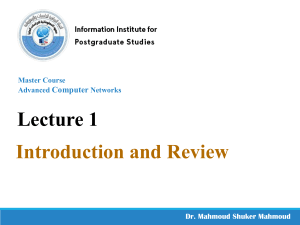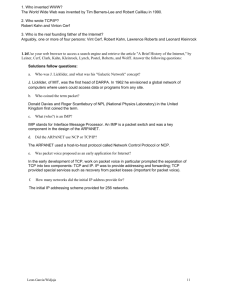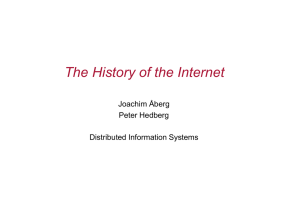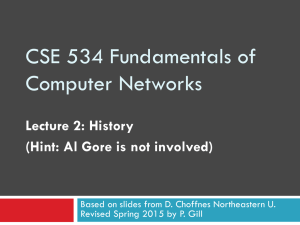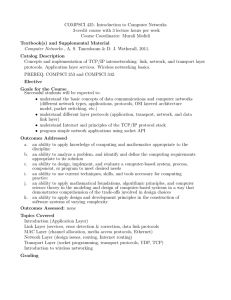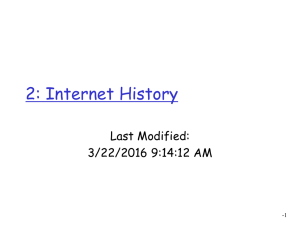A BRIEF HISTORY
advertisement
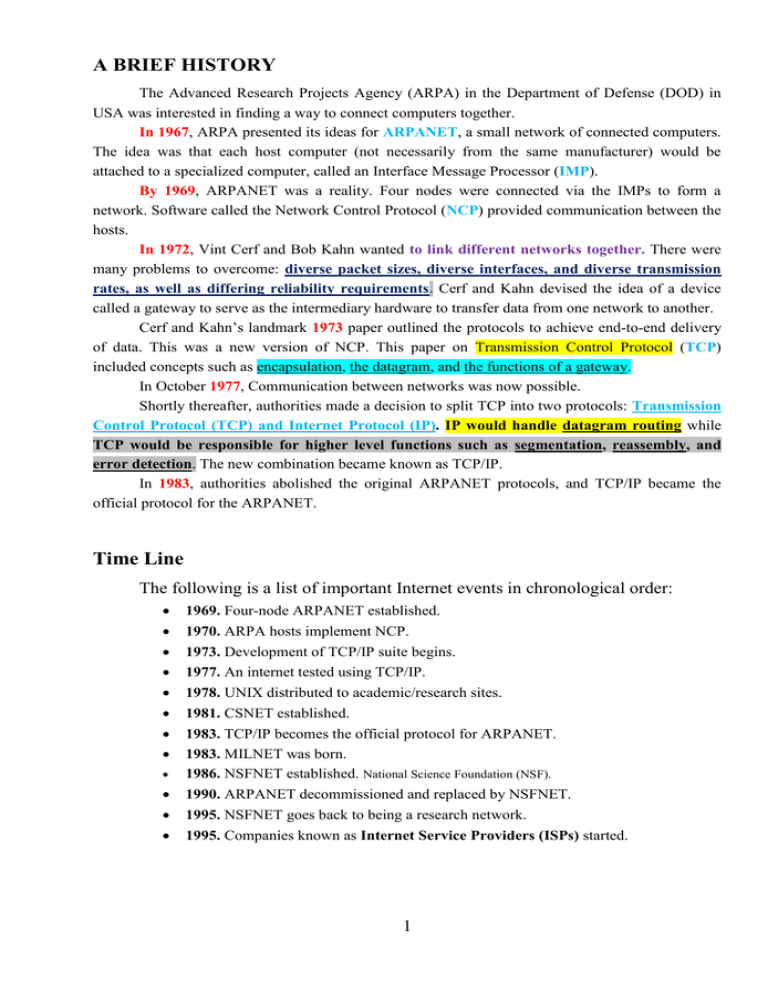
A BRIEF HISTORY The Advanced Research Projects Agency (ARPA) in the Department of Defense (DOD) in USA was interested in finding a way to connect computers together. In 1967, ARPA presented its ideas for ARPANET, a small network of connected computers. The idea was that each host computer (not necessarily from the same manufacturer) would be attached to a specialized computer, called an Interface Message Processor (IMP). By 1969, ARPANET was a reality. Four nodes were connected via the IMPs to form a network. Software called the Network Control Protocol (NCP) provided communication between the hosts. In 1972, Vint Cerf and Bob Kahn wanted to link different networks together. There were many problems to overcome: diverse packet sizes, diverse interfaces, and diverse transmission rates, as well as differing reliability requirements. Cerf and Kahn devised the idea of a device called a gateway to serve as the intermediary hardware to transfer data from one network to another. Cerf and Kahn’s landmark 1973 paper outlined the protocols to achieve end-to-end delivery of data. This was a new version of NCP. This paper on Transmission Control Protocol (TCP) included concepts such as encapsulation, the datagram, and the functions of a gateway. In October 1977, Communication between networks was now possible. Shortly thereafter, authorities made a decision to split TCP into two protocols: Transmission Control Protocol (TCP) and Internet Protocol (IP). IP would handle datagram routing while TCP would be responsible for higher level functions such as segmentation, reassembly, and error detection. The new combination became known as TCP/IP. In 1983, authorities abolished the original ARPANET protocols, and TCP/IP became the official protocol for the ARPANET. Time Line The following is a list of important Internet events in chronological order: 1969. Four-node ARPANET established. 1970. ARPA hosts implement NCP. 1973. Development of TCP/IP suite begins. 1977. An internet tested using TCP/IP. 1978. UNIX distributed to academic/research sites. 1981. CSNET established. 1983. TCP/IP becomes the official protocol for ARPANET. 1983. MILNET was born. 1986. NSFNET established. National Science Foundation (NSF). 1990. ARPANET decommissioned and replaced by NSFNET. 1995. NSFNET goes back to being a research network. 1995. Companies known as Internet Service Providers (ISPs) started. 1 Growth of the Internet - internet ( lowercase i ) is two or more networks that can communicate with each other. - Internet (uppercase I ), composed of hundreds of thousands of interconnected networks. The Internet has grown tremendously. Factors that have an impact on this growth include the following: New Protocols. New protocols need to be added and deprecated ones need to be removed. New Technology. New technologies are under development that will increase the capacity of networks and provide more bandwidth to the Internet’s users. Increasing Use of Multimedia. It is predicted that the Internet, once just a vehicle to share data, will be used more and more for multimedia (audio and video). PROTOCOLS AND STANDARDS Protocol: which is synonymous with rule. Standards: which are agreed-upon rules. protocol A protocol is a set of rules that governs communication. In computer networks, communication occurs between entities in different systems. For communication to occur, the entities must agree on a protocol. A protocol defines what is communicated, how it is communicated, and when it is communicated. The key elements of a protocol are syntax, semantics, and timing. Syntax: Syntax refers to the structure or format of the data, meaning the order in which they are presented. For example, a simple protocol might expect the first 8 bits of data to be the address of the sender, the second 8 bits to be the address of the receiver, and the rest of the stream to be the message itself. Semantics: Semantics refers to the meaning of each section of bits. How is a particular pattern to be interpreted, and what action is to be taken based on that interpretation? For example, does an address identify the route to be taken or the final destination of the message? Timing: Timing refers to two characteristics: when data should be sent and how fast it can be sent. For example, if a sender produces data at 100 megabits per second (100 Mbps) but the receiver can process data at only 1 Mbps, the transmission will overload the receiver and data will be largely lost. Standards Standards are essential in creating and maintaining an open and competitive market for equipment manufacturers and also in guaranteeing national and international interoperability of data and telecommunications technology and processes. They provide guidelines to manufacturers, vendors, government agencies, and other service providers to ensure the kind of interconnectivity necessary in today’s marketplace and in international communications. 2 Data communication standards fall into two categories: de facto (meaning “by fact” or “by convention”) and de jure (meaning “by law” or “by regulation”). De facto: Standards that have not been approved by an organized body but have been adopted as standards through widespread use are de facto standards. De jure: De jure standards are those that have been legislated by an officially recognized body. Standards are developed through the cooperation of standards creation committees, forums, and government regulatory agencies. Standards Creation Committees: International Standards Organization (ISO). American National Standards Institute (ANSI). Institute of Electrical and Electronics Engineers (IEEE). INTERNET STANDARDS An Internet standard is a thoroughly tested specification that is useful to and adhered to by those who work with the Internet. A specification begins as an Internet draft. An Internet draft is a working document (a work in progress) with no official status and a six-month lifetime. Upon recommendation from the Internet authorities, a draft may be published as a Request for Comment (RFC). Each RFC is edited, assigned a number, and made available to all interested parties. RFCs go through maturity levels and are categorized according to their requirement level. Maturity levels of an RFC Requirement levels of an RFC 3 INTERNET ADMINISTRATION Internet Society (ISOC): Provide support for the Internet standards process Promotes research and other scholarly activities relating to the Internet. Internet Architecture Board (IAB): the technical advisor to the ISOC. Oversee the continuing development of the TCP/IP Protocol Suite and to serve in a technical advisory capacity to research members of the Internet community. Editorial management of the RFCs Internet Engineering Task Force (IETF) Responsible for identifying operational problems and proposing solutions to these problems. Develops and reviews specifications intended as Internet standards. The working groups are collected into areas, and each area concentrates on a specific topic. The areas are: Applications Internet protocols Routing Operations User services Network management Transport Internet protocol next generation (IPng) Security 4 Internet Research Task Force (IRTF) Focuses on long-term research topics related to Internet protocols, applications, architecture, and technology. Internet Assigned Numbers Authority (IANA) and Internet Corporation for Assigned Names and Numbers (ICANN) Responsible for the management of Internet domain names and addresses until October 1998. At that time the Internet Corporation for Assigned Names and Numbers (ICANN) assumed IANA operations. Network Information Center (NIC) The Network Information Center (NIC) is responsible for collecting and distributing information about TCP/IP protocols. 5
